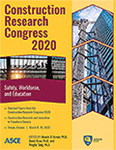Construction Research Congress 2020
Identification of Construction Safety Risks Based on Text Mining and LIBSVM Method
Publication: Construction Research Congress 2020: Safety, Workforce, and Education
ABSTRACT
The construction industry is an important pillar of the national economy in many countries, but it is also regarded as one of the most dangerous industries. To lower the rate of construction accidents and facilitate national economic growth, safety control is always the most frequently discussed topic in recent years. In China, government supervision plays an important role in this part by taking regularly inspections on construction sites to ensure control of construction safety. For safety risks such as improper operations or unsafe facilities, the government will take an on-site record and then send formal rectification notices to the contractor to improve the safety condition in time. Based on the methods of text mining and machine learning, this paper analyzes these formal notices issued by the Shanghai Municipal Construction Engineering Safety Quality Supervision Center during 2017–2018. Through text mining, 4,801 rectification notices are first processed by word segmentation, followed with word frequency statistics to obtain safety hazard events with high frequency. Then a library for support vector machines (LIBSVM), integrated software for support vector classification, is used to further classify these potential risks. The result has proved the possibility of the LIBSVM-based construction safety factors classification model for both construction contractors and supervision authorities to better control the overall construction safety situation. The study also reveals that facilities like scaffolds, tower crane, and foundation pit may easily turn into potential hazard sources if they cannot meet corresponding regulations. The findings contribute to a deepened understanding of indicators and facilities affecting construction safety which presents a high frequency of occurrence in construction processes.
Get full access to this article
View all available purchase options and get full access to this chapter.
REFERENCES
Chang, C. C., and Lin, C. J. (2011). “LIBSVM: A Library for Support Vector Machines.” ACM Trans. Intell. Syst. Technol., 2(3), 27.
Cheng, C. W., Leu, S. S., Cheng, Y. M., Wu, T. C., and Lin, C. C. (2012). “Applying data mining techniques to explore factors contributing to occupational injuries in Taiwan's construction industry.” Accid. Anal. Prev., 48, 214-222.
Ciarapica, F. E., and Giacchetta, G. (2009). “Classification and prediction of occupational injury risk using soft computing techniques: An Italian study.” Safety Science, 47(1), 36-49.
Fang, D. P., Zhang, J., and Vickridge, I. (2003). “Construction safety legislation framework in China.” Proc. Inst. Civil Eng.-Munic. Eng., 156(3), 169-173.
Goh, Y. M., and Chua, D. (2013). “Neural network analysis of construction safety management systems: a case study in Singapore.” Construction Management and Economics, 31(5), 460-470.
Goh, Y. M., and Ubeynarayana, C. U. (2017). “Construction accident narrative classification: An evaluation of text mining techniques.” Accid. Anal. Prev., 108, 122-130.
Haslam, R.A., Hide, S.A., Gibb, A.G.F., Gyi, D.E., Atkinson, S., Pavitt, T.C., Duff, R., Suraji, A., (2003). “Causal factors in construction accidents”, HSE Report RR156. HMSO, Norwich.
Haslam, R. A., Hide, S. A., Gibb, A. G. F., Gyi, D. E., Pavitt, T., Atkinson, S., and Duff, A. R. (2005). “Contributing factors in construction accidents.” Applied Ergonomics, 36(4), 401-415.
Hinze, J., Pedersen, C., and Fredley, J. (1998). “Identifying root causes of construction injuries.” J. Constr. Eng. Manage.-ASCE, 124(1), 67-71.
Jannadi, O. A., and Bu-Khamsin, M. S. (2002). “Safety factors considered by industrial contractors in Saudi Arabia.” Building and Environment, 37(5), 539-547.
Khosravi, Y., Asilian-Mahabadi, H., Hajizadeh, E., Hassanzadeh-Rangi, N., Bastani, H., and Behzadan, A. H. (2014). “FACTORS INFLUENCING UNSAFE BEHAVIORS AND ACCIDENTS ON CONSTRUCTION SITES: A REVIEW.” Int. J. Occup. Saf. Ergon., 20(1), 111-125.
Lei, M. M., Ge, J. D., Li, Z. J., Li, C. Y., Zhou, Y. M., Zhou, X. Y., and Luo, B. (2017). “Automatically Classify Chinese Judgment Documents Utilizing Machine Learning Algorithms.” Database Systems for Advanced Applications, Z. Bao, G. Trajcevski, L. Chang, and W. Hua, eds., Springer International Publishing Ag, Cham, 3-17.
Ministry of Emergency Management of People’s Republic of China, “Circular on the safety production situation of the national construction industry in the first half of 2018”, <http://www.chinasafety.gov.cn/gk/tzgg/tb/201807/t20180725_230568.shtml>; (Jul. 19, 2018)
Poh, C. Q. X., Ubeynarayana, C. U., and Goh, Y. M. (2018). “Safety leading indicators for construction sites: A machine learning approach.” Automation in Construction, 93, 375-386.
Sunindijo, R. Y., and Zou, P. X. W. (2012). “Political Skill for Developing Construction Safety Climate.” J. Constr. Eng. Manage.-ASCE, 138(5), 605-612.
Tixier, A. J. P., Hallowell, M. R., Rajagopalan, B., and Bowman, D. (2016). “Application of machine learning to construction injury prediction.” Automation in Construction, 69, 102-114.
Xu, Q., Chong, H.-Y., and Liao, P.-C. (2019). “Collaborative information integration for construction safety monitoring.” Automation in Construction, 102, 120-134.
Zhang, F., Fleyeh, H., Wang, X. R., and Lu, M. H. (2019). “Construction site accident analysis using text mining and natural language processing techniques.” Automation in Construction, 99, 238-248.
Zhou, Z., Irizarry, J., and Li, Q. (2013). “Applying advanced technology to improve safety management in the construction industry: a literature review.” Construction Management and Economics, 31(6), 606-622.
Zhou, Z. P., Goh, Y. M., and Li, Q. M. (2015). “Overview and analysis of safety management studies in the construction industry.” Safety Science, 72, 337-350.
Information & Authors
Information
Published In
Construction Research Congress 2020: Safety, Workforce, and Education
Pages: 40 - 48
Editors: Mounir El Asmar, Ph.D., Arizona State University, David Grau, Ph.D., Arizona State University, and Pingbo Tang, Ph.D., Arizona State University
ISBN (Online): 978-0-7844-8287-2
Copyright
© 2020 American Society of Civil Engineers.
History
Published online: Nov 9, 2020
Published in print: Nov 9, 2020
Authors
Metrics & Citations
Metrics
Citations
Download citation
If you have the appropriate software installed, you can download article citation data to the citation manager of your choice. Simply select your manager software from the list below and click Download.
